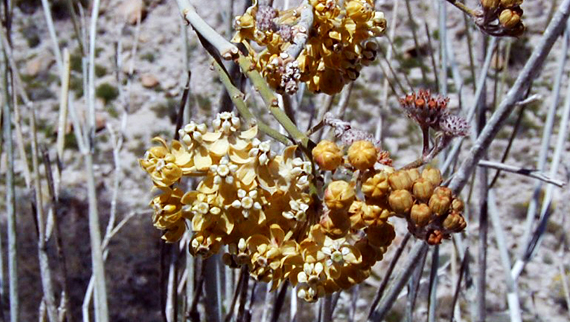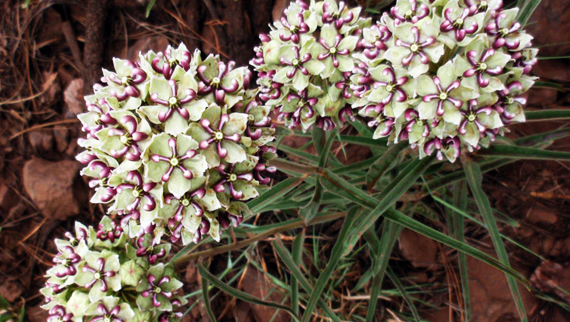





Monarch butterfly populations have declined as much as 90 percent over the last two decades. Desert Botanical Garden is helping monarchs with our Great Milkweed Grow Out initiative through:
- Propagation: Growing native milkweeds to build habitat
- Expanding Monarch Habitat: Planting habitat and milkweed at schools and community centers
- Milkweed Research: Finding the best native milkweeds to support monarch and pollinator populations
Why Milkweed?
Milkweed (genus Asclepias) is the only plant that monarch butterflies can lay their eggs on and that caterpillars can eat. Without milkweed, monarchs will not survive.
How Can You Help?
In the United States, loss of milkweed habitat is a major factor in the decline of the monarchs. You can help by planting milkweed and nectar plants in your backyard.
Find milkweed grown at the Garden in the Garden Shop and biannual plant sales.
Arizona Native Milkweeds
Arizona has at least 29 species of milkweed native to the state, which means you can find the right milkweed for your backyard.
favorite native milkweeds
White stem milkweed (Asclepias albicans)
- Grows to be 8-10 feet tall and 3-4 feet wide.
- Makes a great screen plant once full size.
- Can handle harsh summer heat.
- Requires very little supplemental water once established.
Photo: Barry Breckling


Arizona milkweed (Asclepias angustifolia)
- Grows to be 2-3 feet tall by 2-3 feet wide.
- Prefers some protection from the harsh summer sun.
- This species does best on the east or north side of the house or in light shade/filtered sun.
- This species does better with additional water.
.
Antelope horns milkweed (Asclepias asperula)
- Grows to be 1-2 feet tall.
- Can handle full sun.
- Plant on south, east or west side.
- This species does better with additional water.
Photo: Max Licher


Giant Sand milkweed (Asclepias erosa)
- Grows to be 4-6 feet tall.
- Can handle full sun.
- Plant on south, east or west side.
- This species requires little water.
Photo: Brent Miller
Desert milkweed (Asclepias subulata)
- Grows to be 3-4 feet tall.
- Can handle harsh summer heat.
- Likes to be planted in full sun.
- Requires very little supplemental water once established.
- Great host plant for queen butterflies.


Pineneedle milkweed (Asclepias linaria)
- Grows to be 3-4 feet tall.
- Plant in full sun or partial shade.
- This species does better with additional water.
How to Care for your Native Milkweed:
- Seedlings (in a black cone) can be planted in the ground or in a larger pot. Milkweeds in a 1-gallon pot can be planted in the ground.
- Dig the hole only as deep as the roots but twice as wide. Set the soil aside.
- Carefully remove the plant from the pot, trying not to disturb the roots too much.
- Place the plant in the hole and carefully replace the soil you set aside around the roots. Maintain the soil line (make sure the soil is up to the same point on the plant that it was when the plant was in the pot).
- Gently tamp down the soil around the roots. Add more soil if needed to maintain the soil line.
- Lightly water the plant until the soil is saturated. Use drip irrigation or turn the hose on so the water just trickles.
- Water deeply every day for about 1 week so the roots can get established. Then water every 4-5 days after that. For Asclepias angustifolia, water every 2-3 days. In the summer you can water at the same frequency but for a longer period of time during each watering.